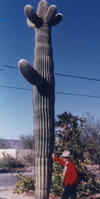
From Phoenix to phantoms, Arizona is a state that lives by contrasts.
The sophistication of the capital city, as well as smaller communities such as Tucson and Scottsdale, hold the political and cultural segments of most of the state. However, its rich environmental and indigenous people have left a legacy for the modern world as well.
The Phoenix area, located on the upper edge of the Sonoran Desert, was settled about 1,700 years ago by the Hohokam people who built a sophisticated series of waterways to irrigate crops. They eventually disappeared, perhaps because of a sustained drought, although no one knows the precise reason.
It took until the 1860s for the area to be reborn, with a farmer named Jack Swilling forming an irrigation company to construct canals to bring lifegiving water to the area. The name "Phoenix" -- after the mythical bird that is reborn from its own fineral pyre -- was selected to represent the strength of the newest settlement.
In 1881, the city was incorporated. The beginning of the tourism boom and a steady rise in people moving here eventually led to Phoenix becoming the seventh largest city in the nation.
The state also is home to several Indian reservations and numerous Indian communities. Some welcome tourists, others are quite private. Many of the Indian communities connect natural elements -- such as the towering sauguro cactus seen above -- to their tribal religious and cultural events.
Hot air ballooning and gorgeous scenery are two of the biggest attractions in Monument Valley, and the splendors of the Grand Canyon create one of America's top tourist draws. And, a mixture of natural markings and glyphs carved into the rock surfaces by indigenous people long ago are a drawing card at the Painted Rock State Park.
ON THE WEB
• Colleges and universities
• State parks
• Lodging connections
• Business and finance
• Jim Harvey's Arizona history column